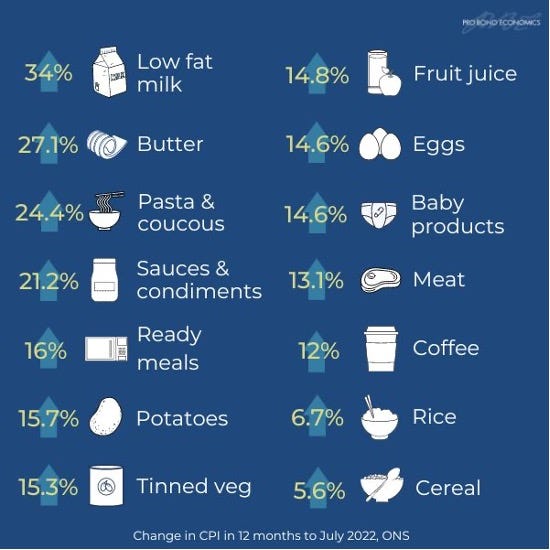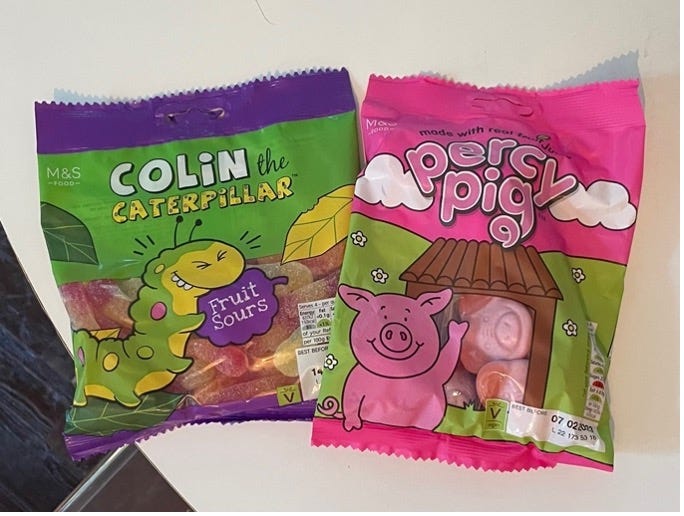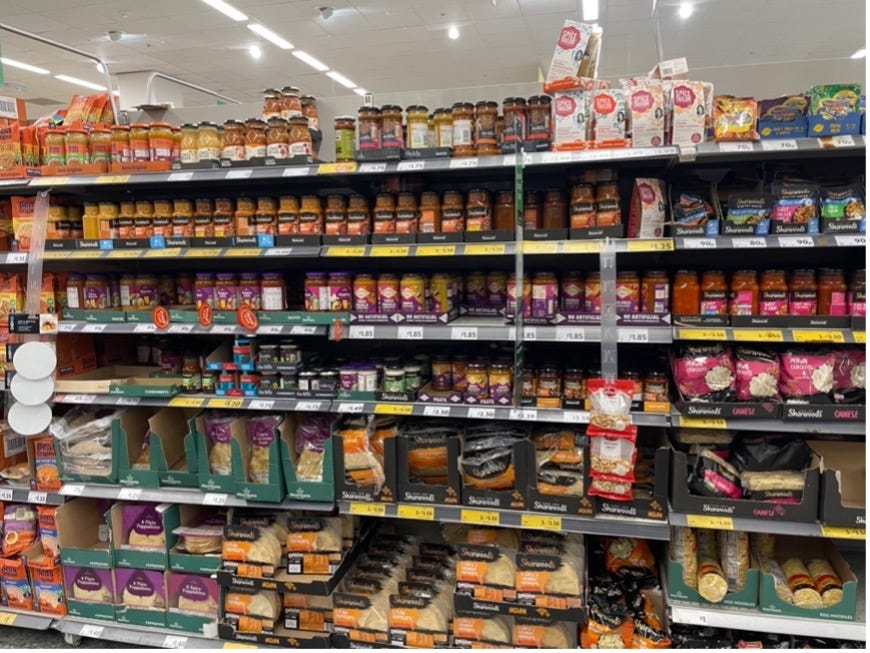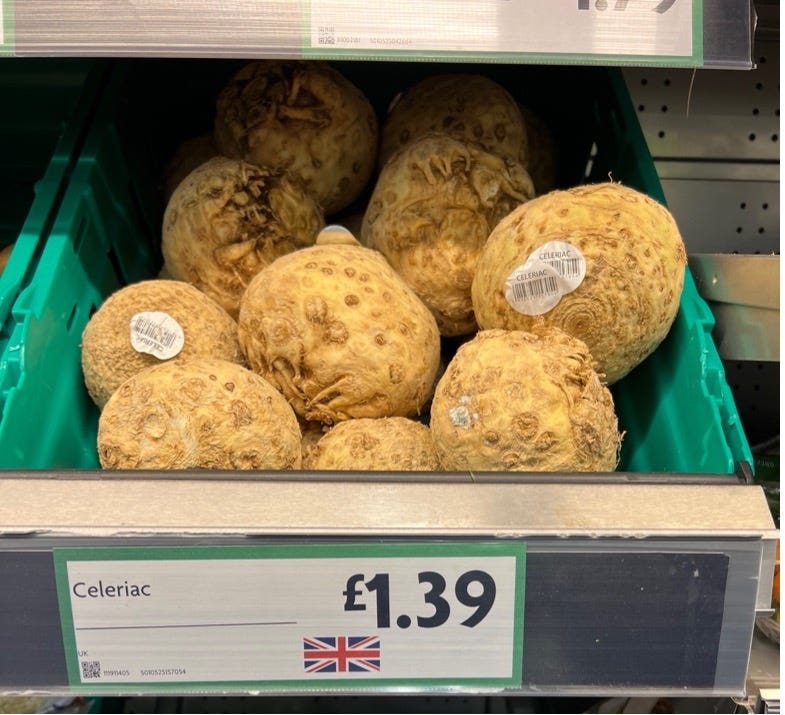As with our other long-stay destinations, we immediately acquainted ourselves with the local grocery store options. I was already familiar with a good number of UK grocery chains from my prior visit. The four biggest supermarket chains in the UK are, in order by market share, Tesco, Sainsbury’s, Asda, and Morrisons. They are similar to large supermarkets in the US (Safeway, Giant, etc.), although my impression is that Sainsbury’s sells products of slightly higher quality and is found in more affluent neighborhoods. You’ll also find small stores, like Tesco Express, in city centers. There are also discount stores (Aldi, Lidl, Iceland, Heron Foods), a more upscale chain (Waitrose), a co-op chain uncreatively named Co-Op, and probably a few others that I’m not aware of.
My favorite is Marks & Spencer (often abbreviated to M&S), which sells a weird combination of groceries and clothing. The grocery side of M&S is the UK’s closest equivalent to Trader Joe’s. They have a lot of prepared and packaged foods, as well as exclusive snacks and sweets. Most famously, they sell Percy Pigs, fruit-flavored gummies in the shape of a cartoon pig face.
M&S sells additional products with the Colin the Caterpillar and Percy Pig brands—cakes, smoothies, backpacks, ice cube trays—and shares recipes online to use the gummies in bizarre concoctions, like nachos and pizza. I enjoy the original gummies, but the other stuff is weird. For example, we spotted a giant Colin the Caterpillar shaped cake and a Percy Pig flavored smoothie. The smoothie is probably made of fruit juice and not gummy-flavored, but I was still too grossed out to try it. Also, the other M&S smoothie I had was inexplicably fizzy, which made me paranoid the Percy Pig one would be too.
Aside from a couple excursions to the M&S, we’ve mostly done our shopping at the Morrisons in Colwyn Bay, which is located inside a small shopping mall. If we lived here permanently with a car, we’d be able to drive to a nearby complex with a Tesco Superstore, Asda, and Iceland and to the M&S, Asda, and Lidl in Llandudno.
I had never been to a Morrisons before. My first impression was that it was better and more diversely stocked than the grocery chains in Ireland, though this could be because it’s two or three times larger than Cahersiveen’s SuperValu. Morrisons has a wide variety of products and more overlap of brands we know from the US. I finally found regular Greek yogurt from a known brand (Fage) after struggling to find Greek yogurt in other countries. We’ve able to buy fresh grapefruit juice, not from concentrate, and Kleenex brand tissues. There is a wide selection of Ben & Jerry’s ice cream pints, including some flavors exclusive to Europe.
There is also a giant “world food” aisle with kits to make tacos and fajitas, multiple shelves of curry sauces, rice noodles, and other Asian products. We tried a Thai green curry kit, which was surprisingly spicy, and an Indian curry we don’t usually see on US shelves.
We also found a few curiosities. In the vegetable aisle, we paused in front of whole celeriac, which we learned after Googling is celery root. It can be used as a potato substitute. I absolutely loathe the taste of celery, so I have not experimented with this.
At the deli counter, you can buy various pies and other meat-heavy British classics, like Scotch eggs and sausage rolls. We were especially amused that you can buy slices of a large pork pie filled with egg. If you watch the Great British Bake Off, you’ll know the contestants sometimes make these giant pies during pastry week. I’ve always assumed the judges force the contestants to bake them as a cruel joke—surely people don’t actually make and eat those pies. But alas, they must, as you can buy a slice from the deli counter as easily as you could buy a tub of fried chicken or potato salad in the US.
The soda aisle had a bizarre flavor we’d never heard of before, “dandelion and burdock,” which centuries ago was brewed as a mead. You may notice the lemonade and limeade on the shelf beside and above the dandelion and burdock. I knew this already, but if you didn’t, lemonade is a fizzy, soda-like drink in the UK, not the sweetened fruit juice drink we know in the US.
Back in the M&S, I noticed a package of butter mints. You won’t be reading about them in the next Alex Goes Snacking post because we did not buy these. Yuck, who wants a half butter-flavored mint? Also, Alex already suffered through one traumatic experience with weird mints in Austria.
Different foods lead me to all the food words that vary from British to American English. There are the easy ones, like chips (French fries), crisps (chips), and biscuits (cookies, though I would define biscuit specifically as a hard, snappy cookie, not a chewy one). Then what we call a biscuit is more akin to, though not quite the same as, a British scone.1
I thought I knew most of these word differences, but there were some I’d forgotten or had never learned. For example, we noticed packages of snow peas in the grocery store labeled “trimmed mangetout.” We knew some British English food words are taken from the French, like courgette (zucchini) and aubergine (eggplant), but we weren’t familiar with this one.
There’s also goujon, which sounds French but isn’t. Despite the fancy-sounding name, these are regular old chicken fingers.
Here are a few other British food words that we rediscovered or learned for the first time while in Wales:
Then there are the words that sound funny, gross, or offensive. Like the jammy dodger, a double layered cookie with jam. We’d more likely call them Linzer cookies. Or the dish “faggots and peas,” where the slur in American English simply means meatballs.
One last note on grocery shopping: The Ukraine war (and probably also Brexit) has increased prices. Alex saw a graphic on Twitter from someone working at a British think tank showing that the prices of everyday food items are up 5-34%.

We aren’t, er, paying the price since the dollar is really, really strong. You may have seen the news about the euro and dollar hitting parity. The pound is also at a historical low compared to the dollar. One pound is currently worth around $1.20. In comparison, the exchange rate was closer to $1.70 when I was here in 2014. Everything is priced a little lower in pounds because one pound is worth more than one dollar, but with the dollar so high in comparison, nothing feels outrageously expensive to us.
Never fear, we haven’t just been cooking at home. More to come in European Gastronomy #8 about our experiences dining out in north Wales.
We felt secondhand embarrassment at a café in Ireland overhearing an American ask for a biscuit and the waiter politely correct him. If you’re in the UK or Ireland, it’s almost certainly a scone!














